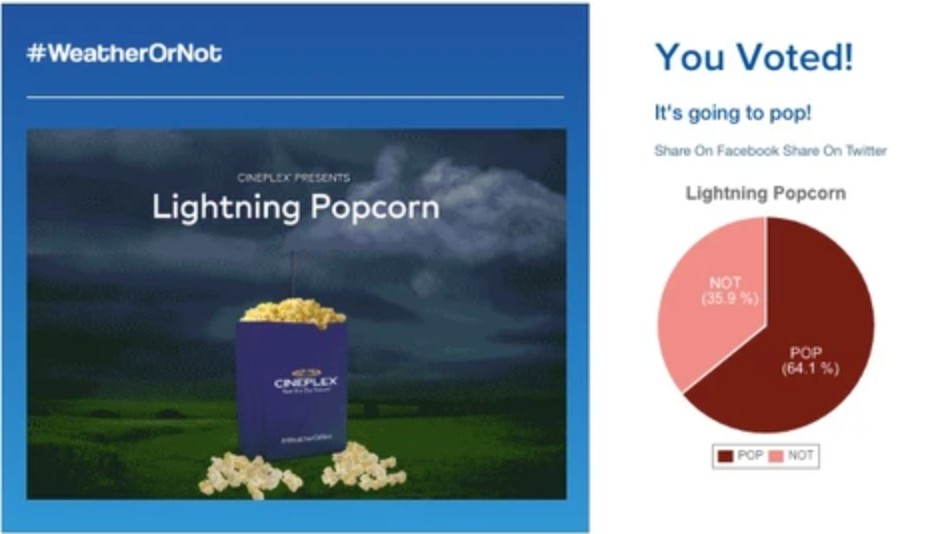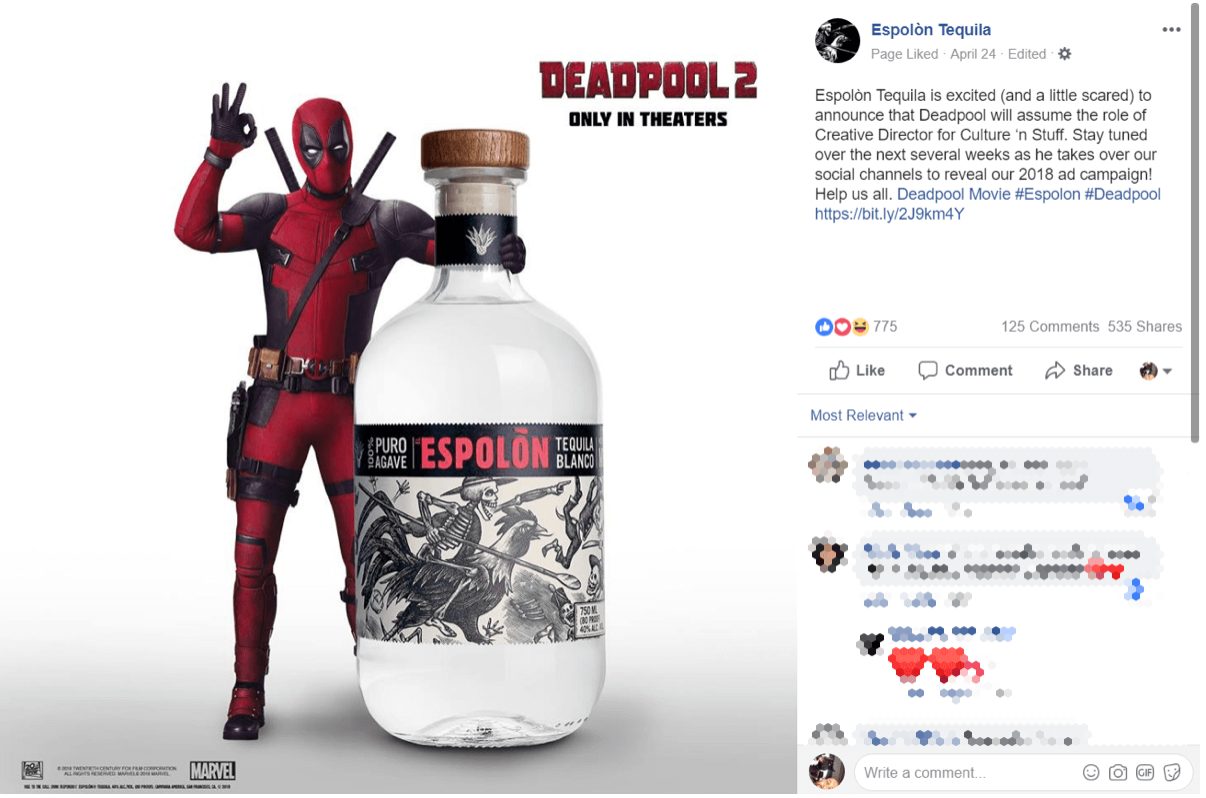Business is inherently about competition.
However, that doesn’t mean you must avoid giving a drop of help to other companies at all costs.
In fact, companies can (and often do) pair up to combine their strengths to launch joint marketing initiatives to great success.
It’s called co-branding.
Co-branding offers a way to raise general brand awareness, gain access to new audiences, improve customer satisfaction (through free giveaways) — all at a high ROI since you’re pooling resources with another brand.
To give you some inspiration for your own partnerships, here’s a list of co-branding campaign ideas that benefit everyone involved.
1. Run a Joint Social Media Campaign
With so many people on social media, it only makes sense to run a social media campaign of some sort.
This tactic can work well for nearly any co-branding strategy, from hosting a contest to launching a brand new joint product (both discussed later).
Check out this example of Marvel teaming up with tequila brand Espolon.
Deadpool was quite a popular movie when it came out (and it still is), so Espolon was able to ride on its coattails and generate new interest in its brand.
Notice the copy, too. It’s humorous and casual, fitting Deadpool’s persona.
If you can, consider tagging each other. By doing this, you send each other social media traffic that can generate visits to your site. You’ll see a boost in SEO and possibly sales.
Learn how other business in your industry are getting clients. Click here to get a tailored analysis with examples.
2. Exchanging Backlinks
Gaining backlinks to your content is a tactic crucial to successfully executing any content marketing strategy.
Backlinks enhance your SEO and search rankings for two reasons:
- Gaining backlinks from authoritative sources boosts your domain authority
- Backlinks send traffic from backlinking sites to yours, and more traffic tells Google your site deserves a higher ranking
As a result, a wealth of quality backlinks can drastically improve brand awareness and sales.
Backlink exchanging works well as a complementary campaign to practically any idea on this list. You can announce your partnership and link to the other brand’s site, and write blog posts about it.
However, another tactic to use would be guest posting. You write a guest article on your partner’s blog in exchange for a backlink to your site and vice-versa.
To do this right, you’ll need to ask for information about your partner’s target audience and do further research yourself.
Then, brainstorm some topics your partner’s audience will find helpful, get them approved by the partner, and write.
Of course, make sure your piece is flawless before it goes live on someone else’s site. You must present yourself in as professional a light as possible to new audiences. Ensure that you adhere to your partner’s style guide. Triple-check for grammar and spelling using a tool like Grammarly, as well as doing your own read-through before submitting the guest post.
3. Host a Webinar
People are staying at home more nowadays, meaning they’re online more often throughout the day.
It’s a perfect opportunity to host a co-branded webinar.
For webinars, it’s a good idea to partner up with someone that’s not a direct competitor but complementary to your business.
For example, if you’re an SEO agency serving a specific industry, you might team up with a web design agency to offer a different service to the same industry. You can each bring your own expertise and knowledge to the table to educate your joint audience.
Both of you likely have a similar audience. This audience may need both services, so you’ll gain customers from your partner and vice-versa.
4. List Swapping
If you’re looking for a low-effort co-branding opportunity, why not just borrow another company’s email list?
Email is a powerful marketing method because it’s more personal. People feel that their email is a private area, so there’s already some built-in trust here.
All you have to do is find suitable companies that you could do a list swap with.
In general, the best companies to swap lists with are those that offer similar products or services.
For example, imagine you run a premium career advice/job board website. A personal finance blog could be a good partner.
People into personal finance would love to know ways to get a raise or higher-paying job for obvious reasons. You might provide them a curated reading list of articles regarding salary negotiation, benefits packages, and similar topics.
From there, you’ll build trust with these new prospects. They might eventually seek jobs through your job board by signing up for a paid subscription.
5. Put On a Hype-Filled Live Event
One way to generate plenty of hype is to work together with another company to put on a live event.
When times return to normal, your live event could have people in attendance. You can do all sorts of things with such an event.
However, there’s no need to sell or give away tickets to an event. You could follow in Red Bull and GoPro’s footsteps.
Both brands are known for exciting events, as they both cater to an adventurous audience. Being an energy drink, Red Bull portrays itself as a lifestyle brand for people who live daring and action-packed lives.
GoPro’s more obvious — athletes and adventurers can strap a GoPro to their head or helmet and capture thrilling footage of stunts and similar events.
Red Bull and GoPro have teamed up for all sorts of races and stunts, but Stratos takes the cake.
Daredevil Felix Baumgartner suited up in Red Bull branded gear, was carried into the stratosphere, strapped a GoPro to himself, and jumped 24 miles back to earth, shattering several records (and the speed of sound) in the process.

Stratos generated significant hype and awareness around both brands. In fact, about eight million people watched Baumgartner’s historic jump live on YouTube.
6. Bundle Your Products Together
Here’s a simple idea: you could simply bundle your products together with another company if the products go well together. This is one of the most direct ways to partner with another brand and gain access to new customers.
Whoever you partner with doesn’t have to be inside your industry, either.
Take a look at the BMW-Louis Vuitton partnership.
BMW is known for its luxurious vehicles. Well, years ago, BMW’s “i” Division was working on a new hybrid luxury sports car, the i8.
Some higher-end vehicles often come with luggage to fit their wealthier customers, so Louis Vuitton saw an opportunity here. They partnered with BMW to create an exclusive set of BMW i8 bags and suitcases that fit perfectly into the parcel shelf behind the backseats.

The luggage itself is around $20,000, but for someone purchasing a $135,000+ luxury sports car, that’s a fair price to pay for such high-quality luggage.
In other words, both companies had totally separate products yet appealed to the same market. Therefore, they were both able to sell more and raise brand awareness.
7. Include Samples or Coupons In Each Other’s Orders
In a similar vein to the previous idea — if you don’t want to design a new product but need to get your current ones into new customer hands, consider shipping some samples or coupons for your product with your partner’s customer orders.
Again, though, you must make sure your partner’s audience is similar to yours. Otherwise, they’re not likely to buy from you later.
For example, imagine you’re doing marketing for your gym or fitness brand. Your audience is going to be health-conscious individuals.
Thus, you could partner with a local meal prep company selling nutritious, pre-made meals and slip some coupons for your products into each of your partner’s orders.
As a result, you would lose a small bit of money upfront on discounted products, but you would gain long-term customers that offset this loss.
8. Work on a Contest Together
People love the chance at winning free stuff and are often willing to give you their information in exchange.
A great co-branding idea is to host a contest where you and/or your partner give away some of your products.
By holding a contest, both of you can attract new customers, gain email addresses for email marketing, and create social media buzz. Plus, by getting a couple of your products into some lucky customers’ hands, you can get some additional feedback and testimonials.
One example of a contest involves Cineplex, a large North American movie theater company, and The Weather Network. They hosted an online contest involving an image of a giant popcorn bag and a lightning rod.
The contest asked participants to guess whether the lightning would hit the corn and subsequently make it pop. If you guessed right, you won free popcorn.

The Weather Network gained plenty of viewers, while Cineplex raised more awareness about its brand.
Conclusion
Co-branding opens up plenty of creative marketing opportunities that can get your brand in front of new customers and build mutually beneficial long-term relationships with other brands. Since you’re sharing resources with another brand, you cut costs, too.
The key is finding a brand selling products or services that complement yours, then presenting a case for how the co-branding campaign helps you both.
So don’t wait around — build a bond with another brand and try some of these co-branding campaign ideas.

Written by our guest writer Brad Smith, Wordable.io
Brad Smith is the CEO at Wordable.io and the Founder of Codeless.com (a content production agency). His content has been highlighted by The New York Times, Business Insider, The Next Web, and thousands more.


